Analysis and Implementation of Iris Recognition Using Standard Cameras
VerifiedAdded on 2022/08/22
|19
|4503
|25
Project
AI Summary
This project investigates the feasibility and efficiency of iris recognition using standard cameras. It begins with an executive summary that highlights the importance of biometric systems and the potential of inexpensive equipment for iris recognition. The project explores the objective, problem statement, and resolution, addressing challenges like noise, occlusion, and focus issues. It delves into biometric identification and image processing techniques, including edge detection, orientation, and the Canny operator. The project also covers methods of iris recognition, including the IR process, segmentation, normalization, mask generation, encoding, matching, and evaluation. It references iris image databases and concludes with future work suggestions. The study aims to implement an iris recognition and identification program using a standard camera, analyze problems during imaging, and assess the efficiency of the methods.
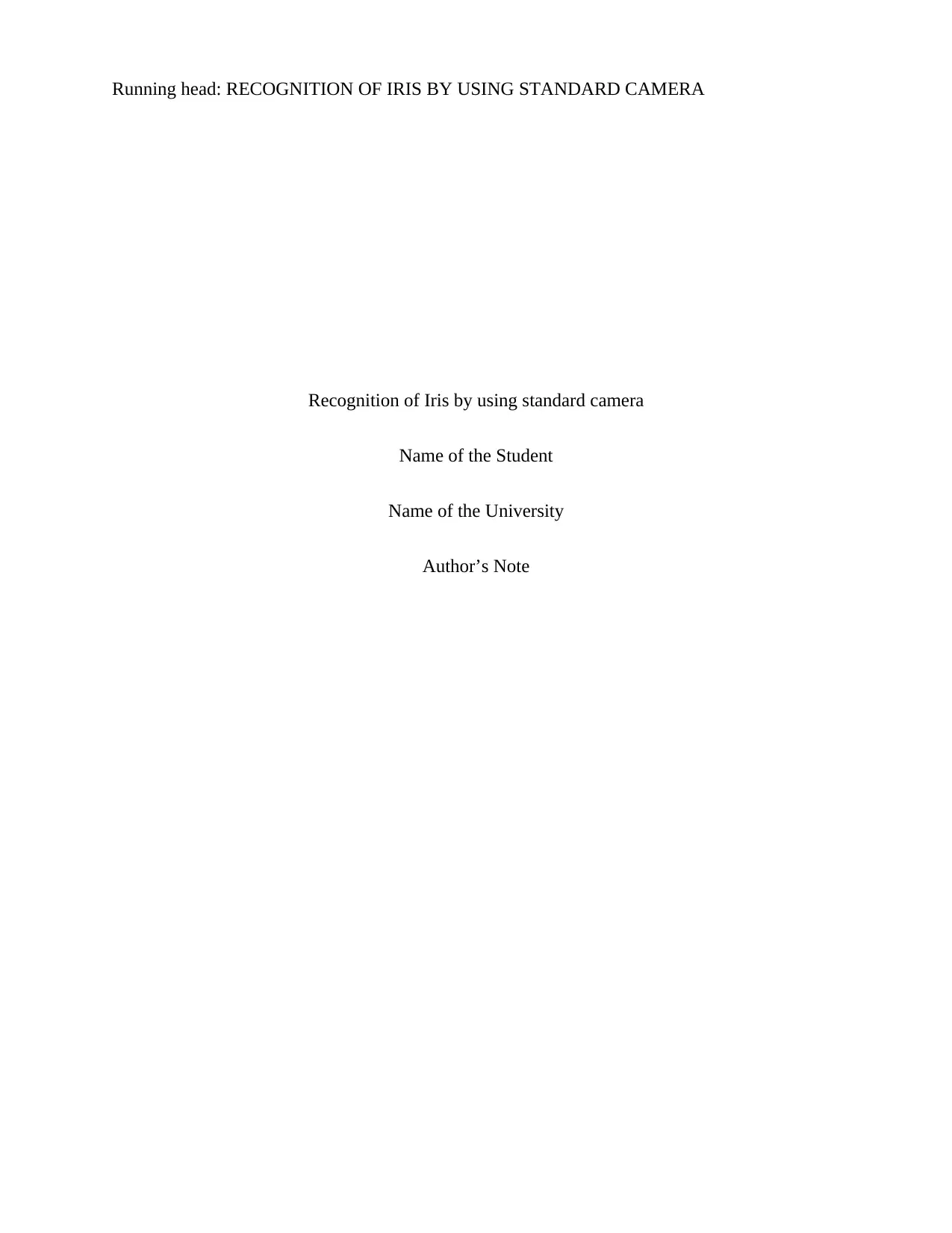
Running head: RECOGNITION OF IRIS BY USING STANDARD CAMERA
Recognition of Iris by using standard camera
Name of the Student
Name of the University
Author’s Note
Recognition of Iris by using standard camera
Name of the Student
Name of the University
Author’s Note
Paraphrase This Document
Need a fresh take? Get an instant paraphrase of this document with our AI Paraphraser
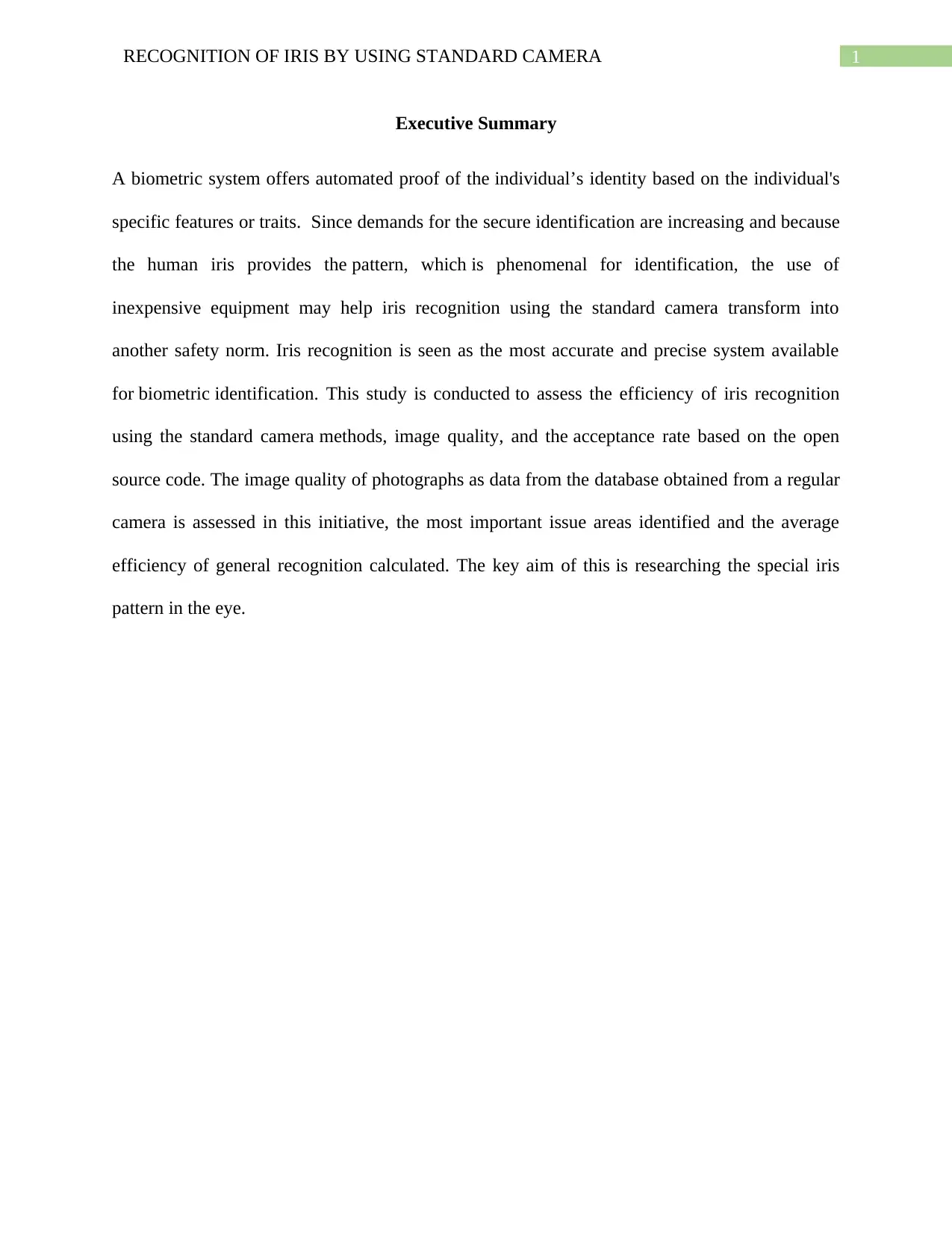
1RECOGNITION OF IRIS BY USING STANDARD CAMERA
Executive Summary
A biometric system offers automated proof of the individual’s identity based on the individual's
specific features or traits. Since demands for the secure identification are increasing and because
the human iris provides the pattern, which is phenomenal for identification, the use of
inexpensive equipment may help iris recognition using the standard camera transform into
another safety norm. Iris recognition is seen as the most accurate and precise system available
for biometric identification. This study is conducted to assess the efficiency of iris recognition
using the standard camera methods, image quality, and the acceptance rate based on the open
source code. The image quality of photographs as data from the database obtained from a regular
camera is assessed in this initiative, the most important issue areas identified and the average
efficiency of general recognition calculated. The key aim of this is researching the special iris
pattern in the eye.
Executive Summary
A biometric system offers automated proof of the individual’s identity based on the individual's
specific features or traits. Since demands for the secure identification are increasing and because
the human iris provides the pattern, which is phenomenal for identification, the use of
inexpensive equipment may help iris recognition using the standard camera transform into
another safety norm. Iris recognition is seen as the most accurate and precise system available
for biometric identification. This study is conducted to assess the efficiency of iris recognition
using the standard camera methods, image quality, and the acceptance rate based on the open
source code. The image quality of photographs as data from the database obtained from a regular
camera is assessed in this initiative, the most important issue areas identified and the average
efficiency of general recognition calculated. The key aim of this is researching the special iris
pattern in the eye.

2RECOGNITION OF IRIS BY USING STANDARD CAMERA
Table of Contents
Introduction......................................................................................................................................4
Iris recognition using standard cameras......................................................................................5
Objective......................................................................................................................................5
Problem Statement...........................................................................................................................6
Resolution....................................................................................................................................6
Reflections...................................................................................................................................6
Noise............................................................................................................................................7
Occlusion.....................................................................................................................................7
Focus............................................................................................................................................7
Biometric identification for IR........................................................................................................8
Image processing for IR...................................................................................................................8
Edge detection.............................................................................................................................8
Orientation in the image..............................................................................................................9
Canny operator.............................................................................................................................9
Methods of Iris recognition.............................................................................................................9
IR process....................................................................................................................................9
Segmentation.............................................................................................................................10
Normalization............................................................................................................................11
Mask generation.........................................................................................................................11
Table of Contents
Introduction......................................................................................................................................4
Iris recognition using standard cameras......................................................................................5
Objective......................................................................................................................................5
Problem Statement...........................................................................................................................6
Resolution....................................................................................................................................6
Reflections...................................................................................................................................6
Noise............................................................................................................................................7
Occlusion.....................................................................................................................................7
Focus............................................................................................................................................7
Biometric identification for IR........................................................................................................8
Image processing for IR...................................................................................................................8
Edge detection.............................................................................................................................8
Orientation in the image..............................................................................................................9
Canny operator.............................................................................................................................9
Methods of Iris recognition.............................................................................................................9
IR process....................................................................................................................................9
Segmentation.............................................................................................................................10
Normalization............................................................................................................................11
Mask generation.........................................................................................................................11
⊘ This is a preview!⊘
Do you want full access?
Subscribe today to unlock all pages.

Trusted by 1+ million students worldwide

3RECOGNITION OF IRIS BY USING STANDARD CAMERA
Encoding and matching.............................................................................................................11
Evaluation......................................................................................................................................12
Iris image databases used...........................................................................................................12
Conclusion.....................................................................................................................................13
Future Work...................................................................................................................................14
References......................................................................................................................................16
Encoding and matching.............................................................................................................11
Evaluation......................................................................................................................................12
Iris image databases used...........................................................................................................12
Conclusion.....................................................................................................................................13
Future Work...................................................................................................................................14
References......................................................................................................................................16
Paraphrase This Document
Need a fresh take? Get an instant paraphrase of this document with our AI Paraphraser
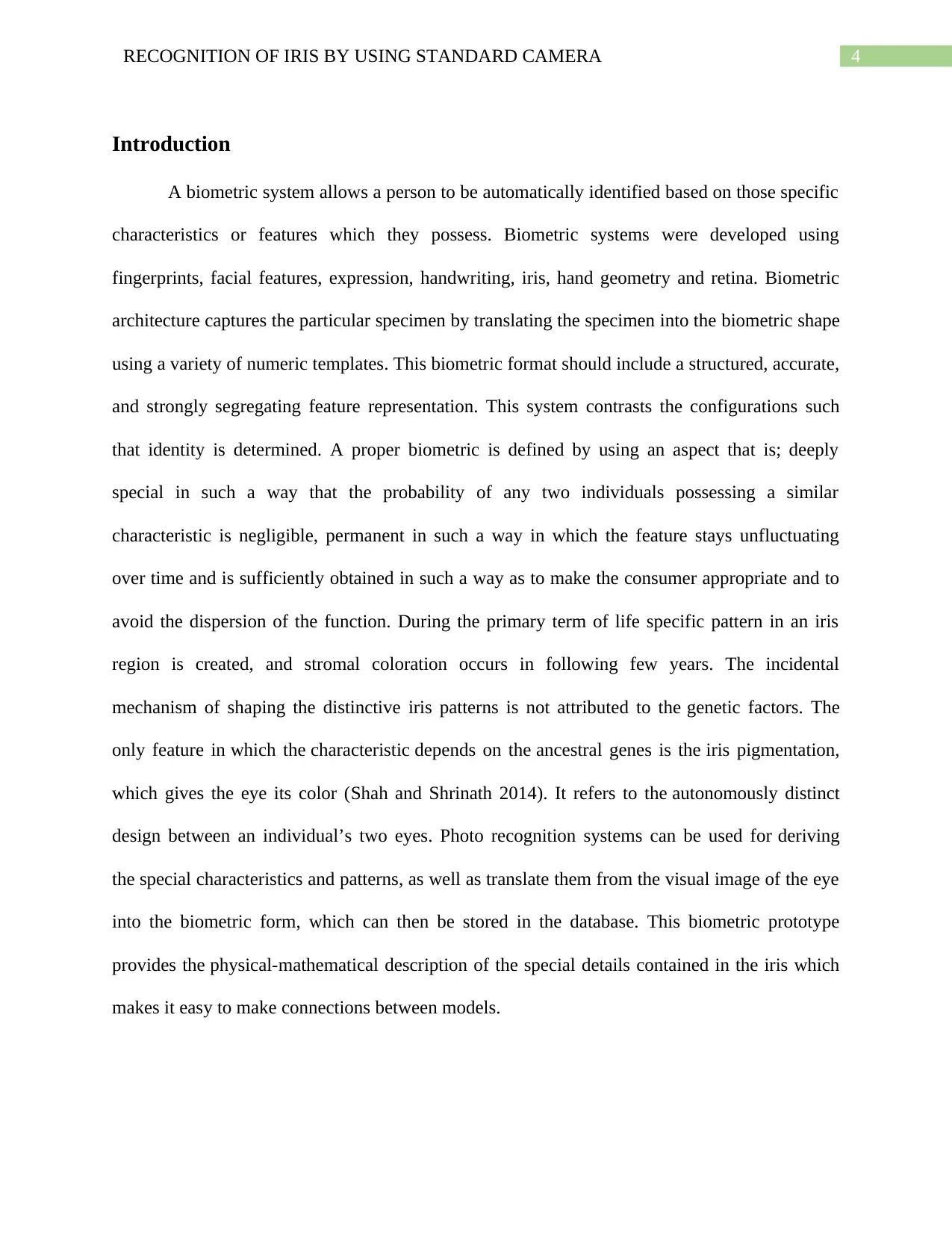
4RECOGNITION OF IRIS BY USING STANDARD CAMERA
Introduction
A biometric system allows a person to be automatically identified based on those specific
characteristics or features which they possess. Biometric systems were developed using
fingerprints, facial features, expression, handwriting, iris, hand geometry and retina. Biometric
architecture captures the particular specimen by translating the specimen into the biometric shape
using a variety of numeric templates. This biometric format should include a structured, accurate,
and strongly segregating feature representation. This system contrasts the configurations such
that identity is determined. A proper biometric is defined by using an aspect that is; deeply
special in such a way that the probability of any two individuals possessing a similar
characteristic is negligible, permanent in such a way in which the feature stays unfluctuating
over time and is sufficiently obtained in such a way as to make the consumer appropriate and to
avoid the dispersion of the function. During the primary term of life specific pattern in an iris
region is created, and stromal coloration occurs in following few years. The incidental
mechanism of shaping the distinctive iris patterns is not attributed to the genetic factors. The
only feature in which the characteristic depends on the ancestral genes is the iris pigmentation,
which gives the eye its color (Shah and Shrinath 2014). It refers to the autonomously distinct
design between an individual’s two eyes. Photo recognition systems can be used for deriving
the special characteristics and patterns, as well as translate them from the visual image of the eye
into the biometric form, which can then be stored in the database. This biometric prototype
provides the physical-mathematical description of the special details contained in the iris which
makes it easy to make connections between models.
Introduction
A biometric system allows a person to be automatically identified based on those specific
characteristics or features which they possess. Biometric systems were developed using
fingerprints, facial features, expression, handwriting, iris, hand geometry and retina. Biometric
architecture captures the particular specimen by translating the specimen into the biometric shape
using a variety of numeric templates. This biometric format should include a structured, accurate,
and strongly segregating feature representation. This system contrasts the configurations such
that identity is determined. A proper biometric is defined by using an aspect that is; deeply
special in such a way that the probability of any two individuals possessing a similar
characteristic is negligible, permanent in such a way in which the feature stays unfluctuating
over time and is sufficiently obtained in such a way as to make the consumer appropriate and to
avoid the dispersion of the function. During the primary term of life specific pattern in an iris
region is created, and stromal coloration occurs in following few years. The incidental
mechanism of shaping the distinctive iris patterns is not attributed to the genetic factors. The
only feature in which the characteristic depends on the ancestral genes is the iris pigmentation,
which gives the eye its color (Shah and Shrinath 2014). It refers to the autonomously distinct
design between an individual’s two eyes. Photo recognition systems can be used for deriving
the special characteristics and patterns, as well as translate them from the visual image of the eye
into the biometric form, which can then be stored in the database. This biometric prototype
provides the physical-mathematical description of the special details contained in the iris which
makes it easy to make connections between models.
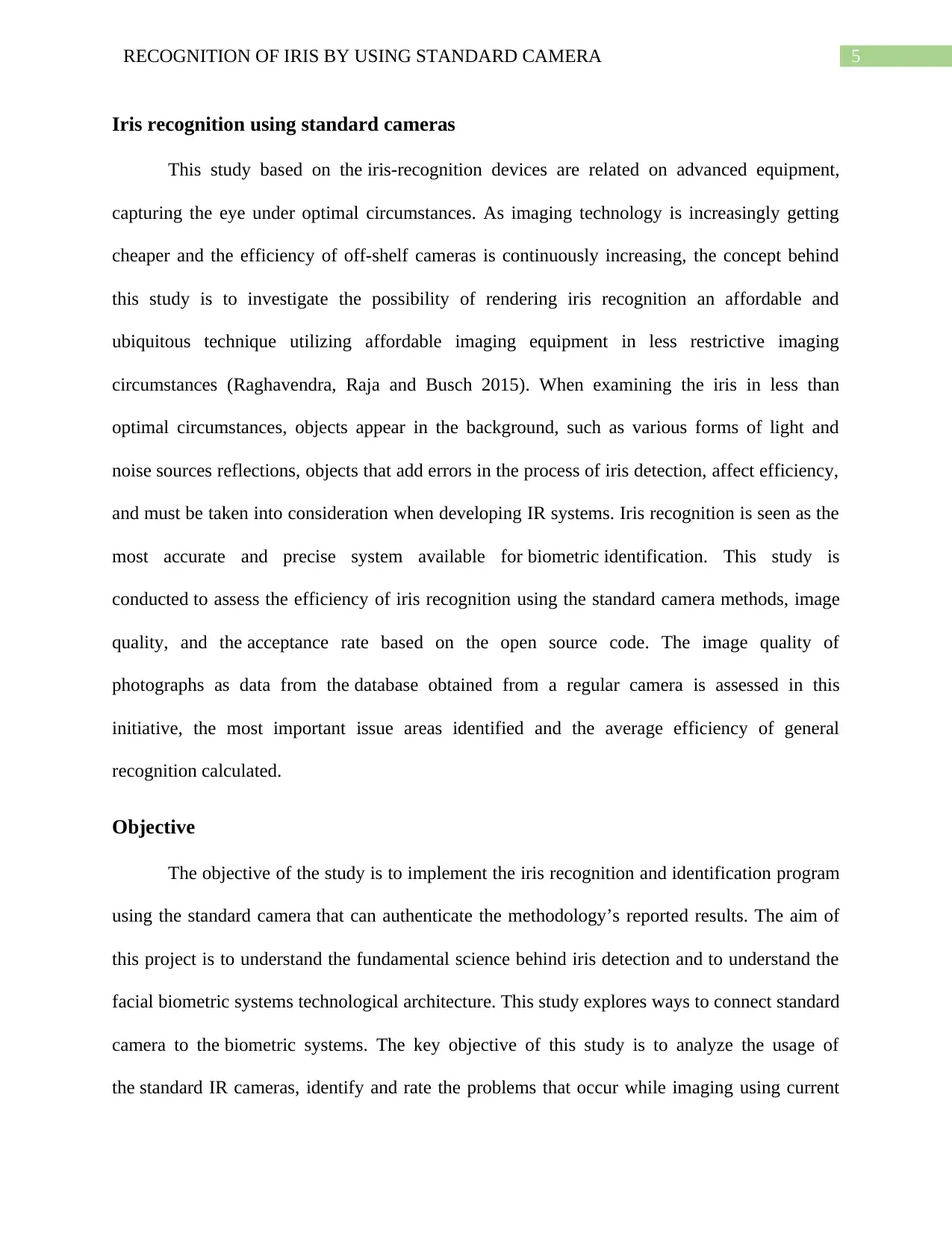
5RECOGNITION OF IRIS BY USING STANDARD CAMERA
Iris recognition using standard cameras
This study based on the iris-recognition devices are related on advanced equipment,
capturing the eye under optimal circumstances. As imaging technology is increasingly getting
cheaper and the efficiency of off-shelf cameras is continuously increasing, the concept behind
this study is to investigate the possibility of rendering iris recognition an affordable and
ubiquitous technique utilizing affordable imaging equipment in less restrictive imaging
circumstances (Raghavendra, Raja and Busch 2015). When examining the iris in less than
optimal circumstances, objects appear in the background, such as various forms of light and
noise sources reflections, objects that add errors in the process of iris detection, affect efficiency,
and must be taken into consideration when developing IR systems. Iris recognition is seen as the
most accurate and precise system available for biometric identification. This study is
conducted to assess the efficiency of iris recognition using the standard camera methods, image
quality, and the acceptance rate based on the open source code. The image quality of
photographs as data from the database obtained from a regular camera is assessed in this
initiative, the most important issue areas identified and the average efficiency of general
recognition calculated.
Objective
The objective of the study is to implement the iris recognition and identification program
using the standard camera that can authenticate the methodology’s reported results. The aim of
this project is to understand the fundamental science behind iris detection and to understand the
facial biometric systems technological architecture. This study explores ways to connect standard
camera to the biometric systems. The key objective of this study is to analyze the usage of
the standard IR cameras, identify and rate the problems that occur while imaging using current
Iris recognition using standard cameras
This study based on the iris-recognition devices are related on advanced equipment,
capturing the eye under optimal circumstances. As imaging technology is increasingly getting
cheaper and the efficiency of off-shelf cameras is continuously increasing, the concept behind
this study is to investigate the possibility of rendering iris recognition an affordable and
ubiquitous technique utilizing affordable imaging equipment in less restrictive imaging
circumstances (Raghavendra, Raja and Busch 2015). When examining the iris in less than
optimal circumstances, objects appear in the background, such as various forms of light and
noise sources reflections, objects that add errors in the process of iris detection, affect efficiency,
and must be taken into consideration when developing IR systems. Iris recognition is seen as the
most accurate and precise system available for biometric identification. This study is
conducted to assess the efficiency of iris recognition using the standard camera methods, image
quality, and the acceptance rate based on the open source code. The image quality of
photographs as data from the database obtained from a regular camera is assessed in this
initiative, the most important issue areas identified and the average efficiency of general
recognition calculated.
Objective
The objective of the study is to implement the iris recognition and identification program
using the standard camera that can authenticate the methodology’s reported results. The aim of
this project is to understand the fundamental science behind iris detection and to understand the
facial biometric systems technological architecture. This study explores ways to connect standard
camera to the biometric systems. The key objective of this study is to analyze the usage of
the standard IR cameras, identify and rate the problems that occur while imaging using current
⊘ This is a preview!⊘
Do you want full access?
Subscribe today to unlock all pages.

Trusted by 1+ million students worldwide
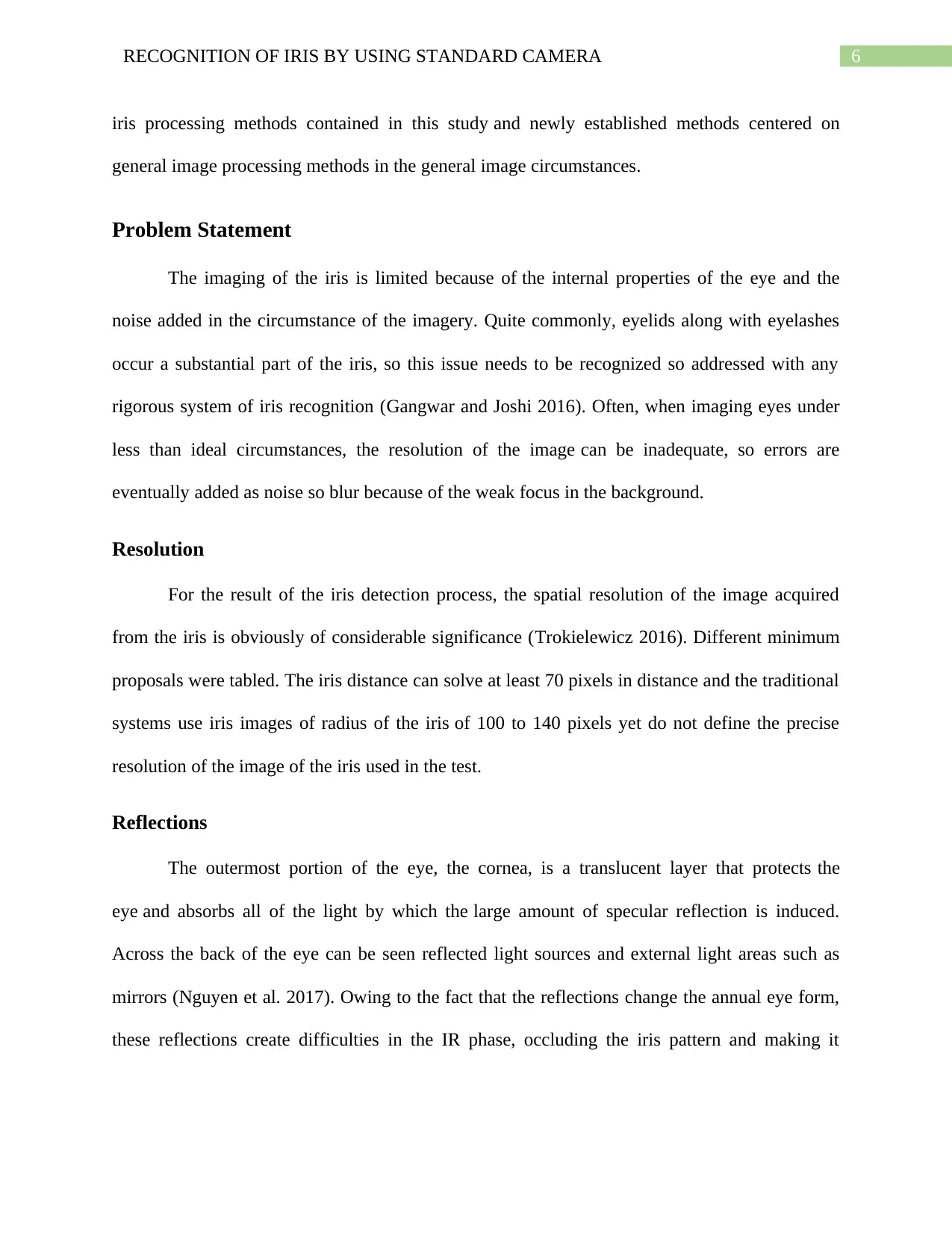
6RECOGNITION OF IRIS BY USING STANDARD CAMERA
iris processing methods contained in this study and newly established methods centered on
general image processing methods in the general image circumstances.
Problem Statement
The imaging of the iris is limited because of the internal properties of the eye and the
noise added in the circumstance of the imagery. Quite commonly, eyelids along with eyelashes
occur a substantial part of the iris, so this issue needs to be recognized so addressed with any
rigorous system of iris recognition (Gangwar and Joshi 2016). Often, when imaging eyes under
less than ideal circumstances, the resolution of the image can be inadequate, so errors are
eventually added as noise so blur because of the weak focus in the background.
Resolution
For the result of the iris detection process, the spatial resolution of the image acquired
from the iris is obviously of considerable significance (Trokielewicz 2016). Different minimum
proposals were tabled. The iris distance can solve at least 70 pixels in distance and the traditional
systems use iris images of radius of the iris of 100 to 140 pixels yet do not define the precise
resolution of the image of the iris used in the test.
Reflections
The outermost portion of the eye, the cornea, is a translucent layer that protects the
eye and absorbs all of the light by which the large amount of specular reflection is induced.
Across the back of the eye can be seen reflected light sources and external light areas such as
mirrors (Nguyen et al. 2017). Owing to the fact that the reflections change the annual eye form,
these reflections create difficulties in the IR phase, occluding the iris pattern and making it
iris processing methods contained in this study and newly established methods centered on
general image processing methods in the general image circumstances.
Problem Statement
The imaging of the iris is limited because of the internal properties of the eye and the
noise added in the circumstance of the imagery. Quite commonly, eyelids along with eyelashes
occur a substantial part of the iris, so this issue needs to be recognized so addressed with any
rigorous system of iris recognition (Gangwar and Joshi 2016). Often, when imaging eyes under
less than ideal circumstances, the resolution of the image can be inadequate, so errors are
eventually added as noise so blur because of the weak focus in the background.
Resolution
For the result of the iris detection process, the spatial resolution of the image acquired
from the iris is obviously of considerable significance (Trokielewicz 2016). Different minimum
proposals were tabled. The iris distance can solve at least 70 pixels in distance and the traditional
systems use iris images of radius of the iris of 100 to 140 pixels yet do not define the precise
resolution of the image of the iris used in the test.
Reflections
The outermost portion of the eye, the cornea, is a translucent layer that protects the
eye and absorbs all of the light by which the large amount of specular reflection is induced.
Across the back of the eye can be seen reflected light sources and external light areas such as
mirrors (Nguyen et al. 2017). Owing to the fact that the reflections change the annual eye form,
these reflections create difficulties in the IR phase, occluding the iris pattern and making it
Paraphrase This Document
Need a fresh take? Get an instant paraphrase of this document with our AI Paraphraser
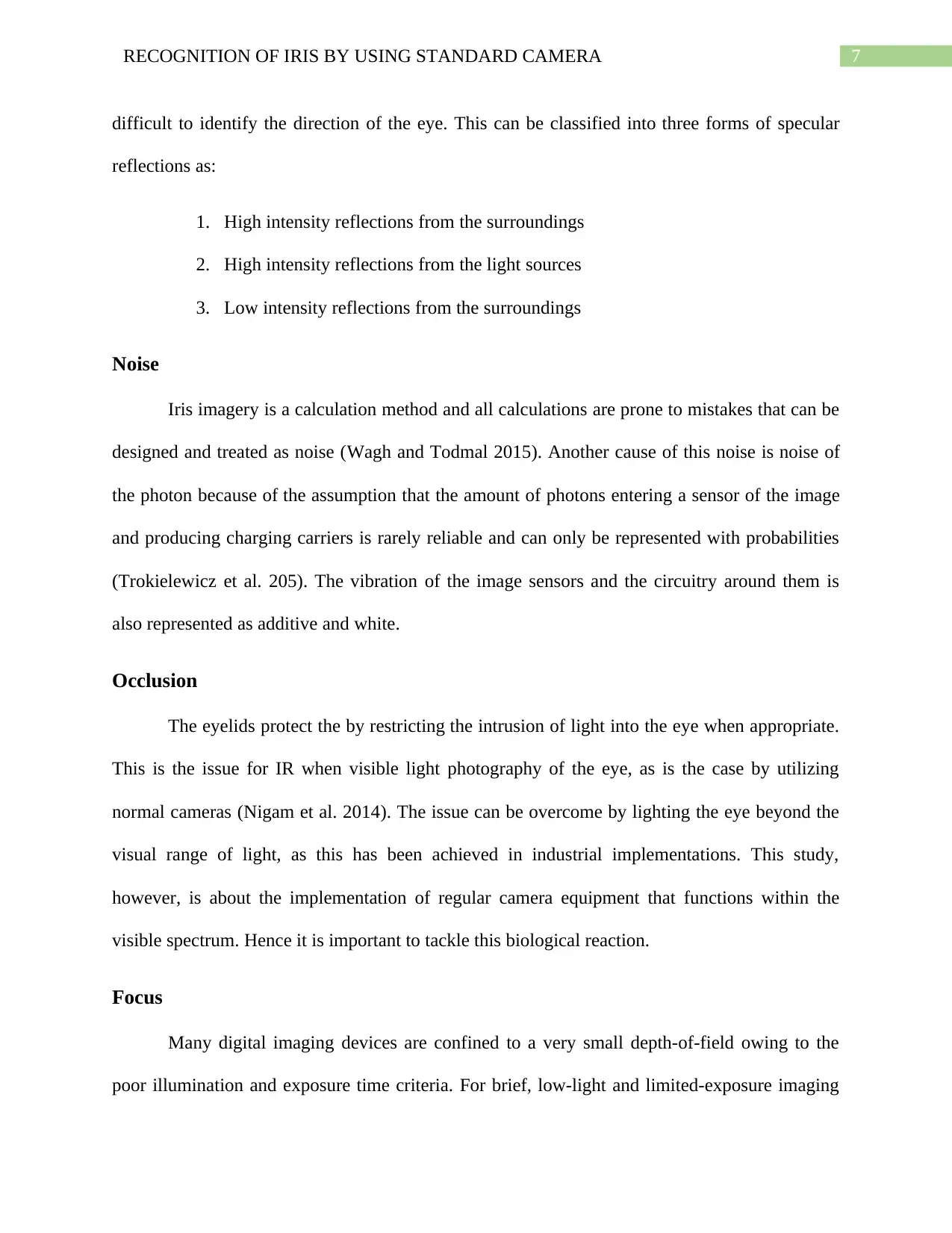
7RECOGNITION OF IRIS BY USING STANDARD CAMERA
difficult to identify the direction of the eye. This can be classified into three forms of specular
reflections as:
1. High intensity reflections from the surroundings
2. High intensity reflections from the light sources
3. Low intensity reflections from the surroundings
Noise
Iris imagery is a calculation method and all calculations are prone to mistakes that can be
designed and treated as noise (Wagh and Todmal 2015). Another cause of this noise is noise of
the photon because of the assumption that the amount of photons entering a sensor of the image
and producing charging carriers is rarely reliable and can only be represented with probabilities
(Trokielewicz et al. 205). The vibration of the image sensors and the circuitry around them is
also represented as additive and white.
Occlusion
The eyelids protect the by restricting the intrusion of light into the eye when appropriate.
This is the issue for IR when visible light photography of the eye, as is the case by utilizing
normal cameras (Nigam et al. 2014). The issue can be overcome by lighting the eye beyond the
visual range of light, as this has been achieved in industrial implementations. This study,
however, is about the implementation of regular camera equipment that functions within the
visible spectrum. Hence it is important to tackle this biological reaction.
Focus
Many digital imaging devices are confined to a very small depth-of-field owing to the
poor illumination and exposure time criteria. For brief, low-light and limited-exposure imaging
difficult to identify the direction of the eye. This can be classified into three forms of specular
reflections as:
1. High intensity reflections from the surroundings
2. High intensity reflections from the light sources
3. Low intensity reflections from the surroundings
Noise
Iris imagery is a calculation method and all calculations are prone to mistakes that can be
designed and treated as noise (Wagh and Todmal 2015). Another cause of this noise is noise of
the photon because of the assumption that the amount of photons entering a sensor of the image
and producing charging carriers is rarely reliable and can only be represented with probabilities
(Trokielewicz et al. 205). The vibration of the image sensors and the circuitry around them is
also represented as additive and white.
Occlusion
The eyelids protect the by restricting the intrusion of light into the eye when appropriate.
This is the issue for IR when visible light photography of the eye, as is the case by utilizing
normal cameras (Nigam et al. 2014). The issue can be overcome by lighting the eye beyond the
visual range of light, as this has been achieved in industrial implementations. This study,
however, is about the implementation of regular camera equipment that functions within the
visible spectrum. Hence it is important to tackle this biological reaction.
Focus
Many digital imaging devices are confined to a very small depth-of-field owing to the
poor illumination and exposure time criteria. For brief, low-light and limited-exposure imaging
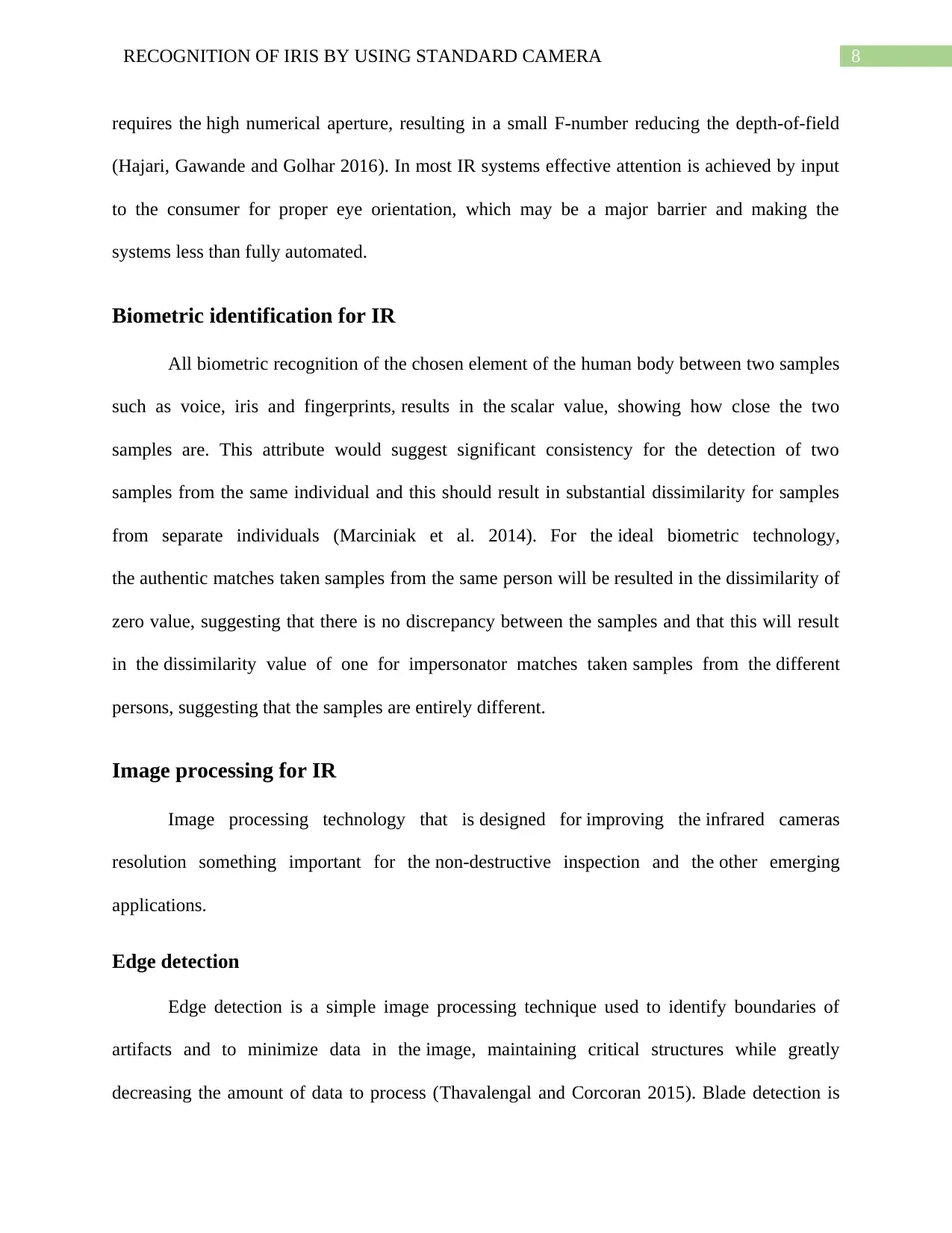
8RECOGNITION OF IRIS BY USING STANDARD CAMERA
requires the high numerical aperture, resulting in a small F-number reducing the depth-of-field
(Hajari, Gawande and Golhar 2016). In most IR systems effective attention is achieved by input
to the consumer for proper eye orientation, which may be a major barrier and making the
systems less than fully automated.
Biometric identification for IR
All biometric recognition of the chosen element of the human body between two samples
such as voice, iris and fingerprints, results in the scalar value, showing how close the two
samples are. This attribute would suggest significant consistency for the detection of two
samples from the same individual and this should result in substantial dissimilarity for samples
from separate individuals (Marciniak et al. 2014). For the ideal biometric technology,
the authentic matches taken samples from the same person will be resulted in the dissimilarity of
zero value, suggesting that there is no discrepancy between the samples and that this will result
in the dissimilarity value of one for impersonator matches taken samples from the different
persons, suggesting that the samples are entirely different.
Image processing for IR
Image processing technology that is designed for improving the infrared cameras
resolution something important for the non-destructive inspection and the other emerging
applications.
Edge detection
Edge detection is a simple image processing technique used to identify boundaries of
artifacts and to minimize data in the image, maintaining critical structures while greatly
decreasing the amount of data to process (Thavalengal and Corcoran 2015). Blade detection is
requires the high numerical aperture, resulting in a small F-number reducing the depth-of-field
(Hajari, Gawande and Golhar 2016). In most IR systems effective attention is achieved by input
to the consumer for proper eye orientation, which may be a major barrier and making the
systems less than fully automated.
Biometric identification for IR
All biometric recognition of the chosen element of the human body between two samples
such as voice, iris and fingerprints, results in the scalar value, showing how close the two
samples are. This attribute would suggest significant consistency for the detection of two
samples from the same individual and this should result in substantial dissimilarity for samples
from separate individuals (Marciniak et al. 2014). For the ideal biometric technology,
the authentic matches taken samples from the same person will be resulted in the dissimilarity of
zero value, suggesting that there is no discrepancy between the samples and that this will result
in the dissimilarity value of one for impersonator matches taken samples from the different
persons, suggesting that the samples are entirely different.
Image processing for IR
Image processing technology that is designed for improving the infrared cameras
resolution something important for the non-destructive inspection and the other emerging
applications.
Edge detection
Edge detection is a simple image processing technique used to identify boundaries of
artifacts and to minimize data in the image, maintaining critical structures while greatly
decreasing the amount of data to process (Thavalengal and Corcoran 2015). Blade detection is
⊘ This is a preview!⊘
Do you want full access?
Subscribe today to unlock all pages.

Trusted by 1+ million students worldwide
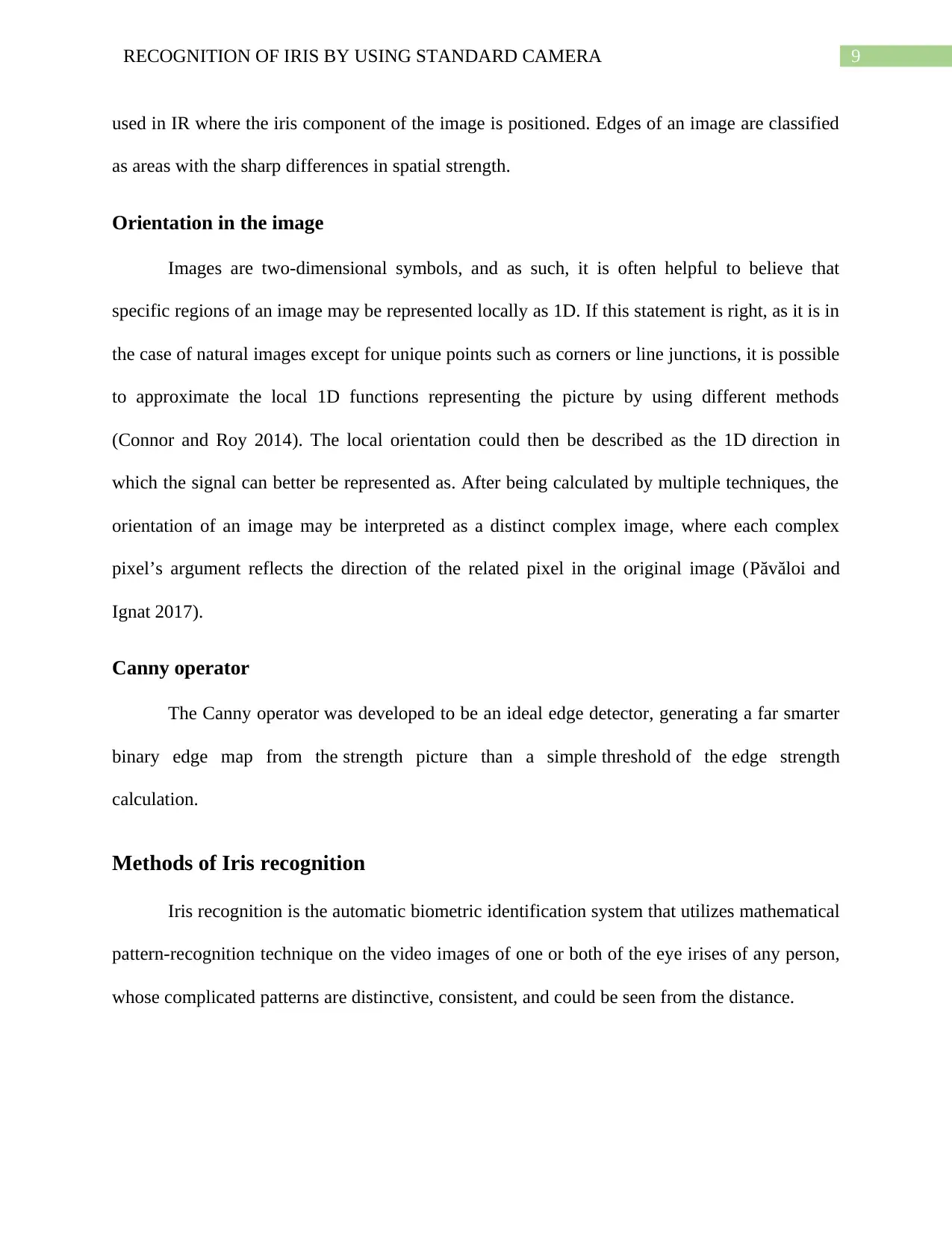
9RECOGNITION OF IRIS BY USING STANDARD CAMERA
used in IR where the iris component of the image is positioned. Edges of an image are classified
as areas with the sharp differences in spatial strength.
Orientation in the image
Images are two-dimensional symbols, and as such, it is often helpful to believe that
specific regions of an image may be represented locally as 1D. If this statement is right, as it is in
the case of natural images except for unique points such as corners or line junctions, it is possible
to approximate the local 1D functions representing the picture by using different methods
(Connor and Roy 2014). The local orientation could then be described as the 1D direction in
which the signal can better be represented as. After being calculated by multiple techniques, the
orientation of an image may be interpreted as a distinct complex image, where each complex
pixel’s argument reflects the direction of the related pixel in the original image (Păvăloi and
Ignat 2017).
Canny operator
The Canny operator was developed to be an ideal edge detector, generating a far smarter
binary edge map from the strength picture than a simple threshold of the edge strength
calculation.
Methods of Iris recognition
Iris recognition is the automatic biometric identification system that utilizes mathematical
pattern-recognition technique on the video images of one or both of the eye irises of any person,
whose complicated patterns are distinctive, consistent, and could be seen from the distance.
used in IR where the iris component of the image is positioned. Edges of an image are classified
as areas with the sharp differences in spatial strength.
Orientation in the image
Images are two-dimensional symbols, and as such, it is often helpful to believe that
specific regions of an image may be represented locally as 1D. If this statement is right, as it is in
the case of natural images except for unique points such as corners or line junctions, it is possible
to approximate the local 1D functions representing the picture by using different methods
(Connor and Roy 2014). The local orientation could then be described as the 1D direction in
which the signal can better be represented as. After being calculated by multiple techniques, the
orientation of an image may be interpreted as a distinct complex image, where each complex
pixel’s argument reflects the direction of the related pixel in the original image (Păvăloi and
Ignat 2017).
Canny operator
The Canny operator was developed to be an ideal edge detector, generating a far smarter
binary edge map from the strength picture than a simple threshold of the edge strength
calculation.
Methods of Iris recognition
Iris recognition is the automatic biometric identification system that utilizes mathematical
pattern-recognition technique on the video images of one or both of the eye irises of any person,
whose complicated patterns are distinctive, consistent, and could be seen from the distance.
Paraphrase This Document
Need a fresh take? Get an instant paraphrase of this document with our AI Paraphraser
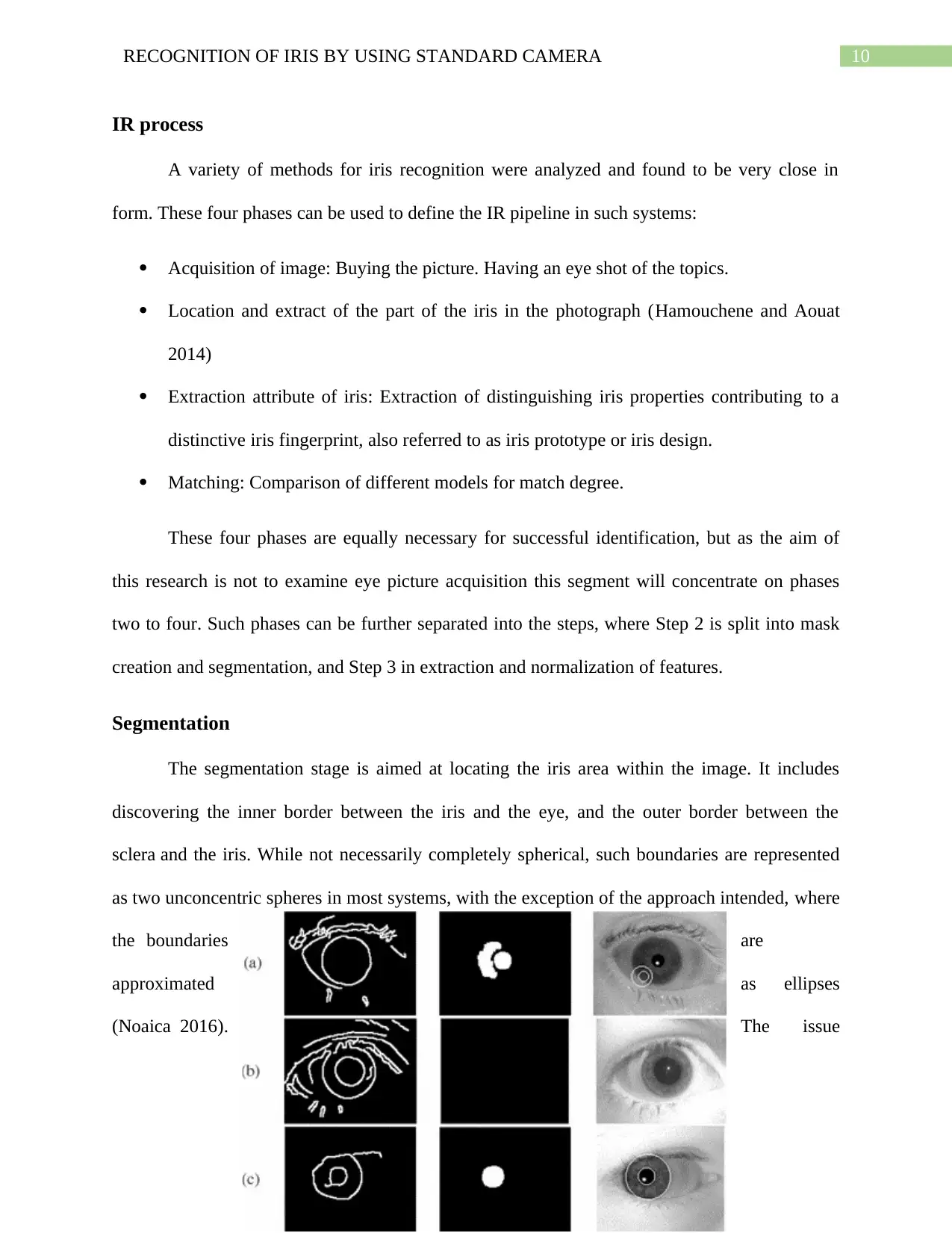
10RECOGNITION OF IRIS BY USING STANDARD CAMERA
IR process
A variety of methods for iris recognition were analyzed and found to be very close in
form. These four phases can be used to define the IR pipeline in such systems:
Acquisition of image: Buying the picture. Having an eye shot of the topics.
Location and extract of the part of the iris in the photograph (Hamouchene and Aouat
2014)
Extraction attribute of iris: Extraction of distinguishing iris properties contributing to a
distinctive iris fingerprint, also referred to as iris prototype or iris design.
Matching: Comparison of different models for match degree.
These four phases are equally necessary for successful identification, but as the aim of
this research is not to examine eye picture acquisition this segment will concentrate on phases
two to four. Such phases can be further separated into the steps, where Step 2 is split into mask
creation and segmentation, and Step 3 in extraction and normalization of features.
Segmentation
The segmentation stage is aimed at locating the iris area within the image. It includes
discovering the inner border between the iris and the eye, and the outer border between the
sclera and the iris. While not necessarily completely spherical, such boundaries are represented
as two unconcentric spheres in most systems, with the exception of the approach intended, where
the boundaries are
approximated as ellipses
(Noaica 2016). The issue
IR process
A variety of methods for iris recognition were analyzed and found to be very close in
form. These four phases can be used to define the IR pipeline in such systems:
Acquisition of image: Buying the picture. Having an eye shot of the topics.
Location and extract of the part of the iris in the photograph (Hamouchene and Aouat
2014)
Extraction attribute of iris: Extraction of distinguishing iris properties contributing to a
distinctive iris fingerprint, also referred to as iris prototype or iris design.
Matching: Comparison of different models for match degree.
These four phases are equally necessary for successful identification, but as the aim of
this research is not to examine eye picture acquisition this segment will concentrate on phases
two to four. Such phases can be further separated into the steps, where Step 2 is split into mask
creation and segmentation, and Step 3 in extraction and normalization of features.
Segmentation
The segmentation stage is aimed at locating the iris area within the image. It includes
discovering the inner border between the iris and the eye, and the outer border between the
sclera and the iris. While not necessarily completely spherical, such boundaries are represented
as two unconcentric spheres in most systems, with the exception of the approach intended, where
the boundaries are
approximated as ellipses
(Noaica 2016). The issue
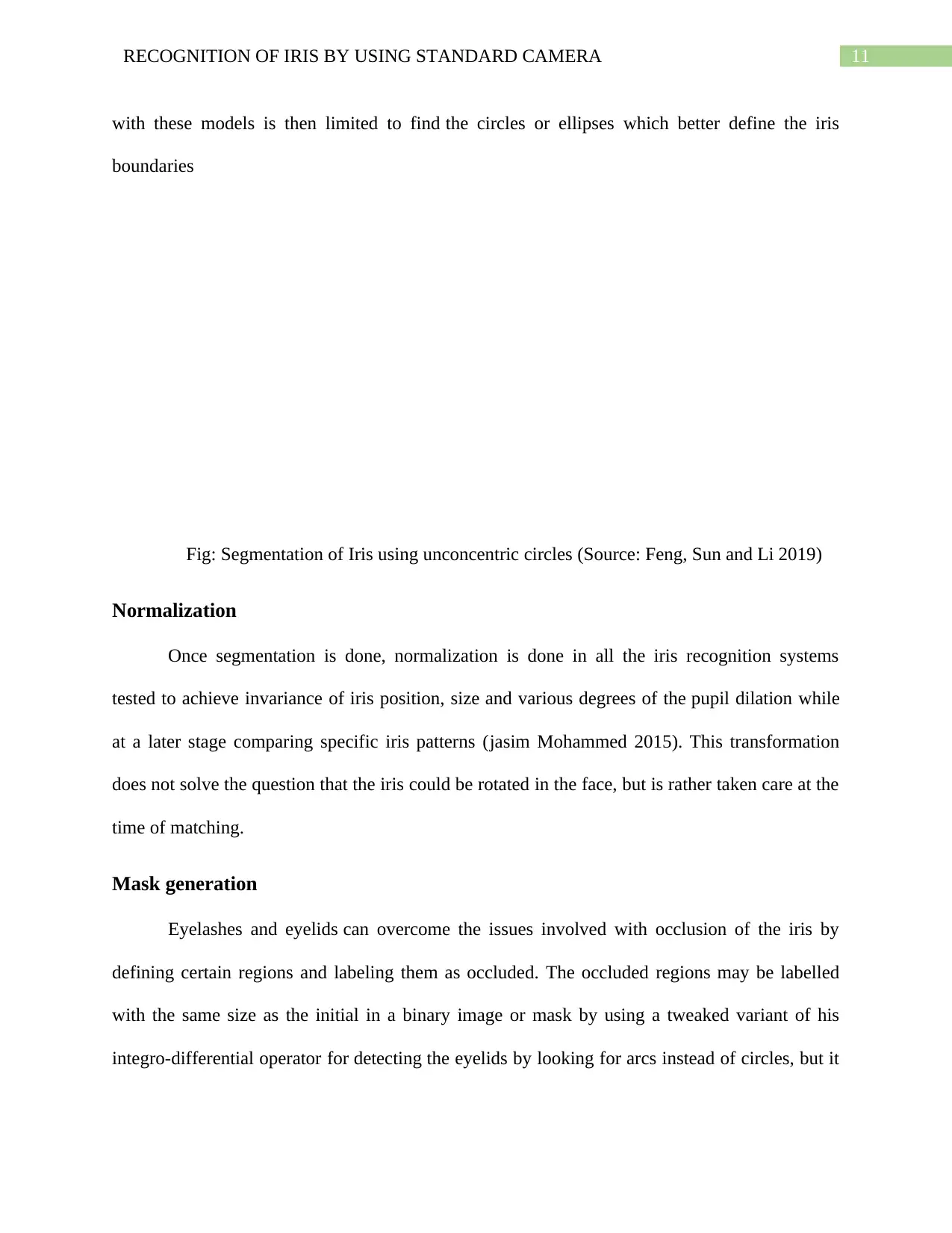
11RECOGNITION OF IRIS BY USING STANDARD CAMERA
with these models is then limited to find the circles or ellipses which better define the iris
boundaries
Fig: Segmentation of Iris using unconcentric circles (Source: Feng, Sun and Li 2019)
Normalization
Once segmentation is done, normalization is done in all the iris recognition systems
tested to achieve invariance of iris position, size and various degrees of the pupil dilation while
at a later stage comparing specific iris patterns (jasim Mohammed 2015). This transformation
does not solve the question that the iris could be rotated in the face, but is rather taken care at the
time of matching.
Mask generation
Eyelashes and eyelids can overcome the issues involved with occlusion of the iris by
defining certain regions and labeling them as occluded. The occluded regions may be labelled
with the same size as the initial in a binary image or mask by using a tweaked variant of his
integro-differential operator for detecting the eyelids by looking for arcs instead of circles, but it
with these models is then limited to find the circles or ellipses which better define the iris
boundaries
Fig: Segmentation of Iris using unconcentric circles (Source: Feng, Sun and Li 2019)
Normalization
Once segmentation is done, normalization is done in all the iris recognition systems
tested to achieve invariance of iris position, size and various degrees of the pupil dilation while
at a later stage comparing specific iris patterns (jasim Mohammed 2015). This transformation
does not solve the question that the iris could be rotated in the face, but is rather taken care at the
time of matching.
Mask generation
Eyelashes and eyelids can overcome the issues involved with occlusion of the iris by
defining certain regions and labeling them as occluded. The occluded regions may be labelled
with the same size as the initial in a binary image or mask by using a tweaked variant of his
integro-differential operator for detecting the eyelids by looking for arcs instead of circles, but it
⊘ This is a preview!⊘
Do you want full access?
Subscribe today to unlock all pages.

Trusted by 1+ million students worldwide
1 out of 19
Related Documents
Your All-in-One AI-Powered Toolkit for Academic Success.
+13062052269
info@desklib.com
Available 24*7 on WhatsApp / Email
![[object Object]](/_next/static/media/star-bottom.7253800d.svg)
Unlock your academic potential
Copyright © 2020–2025 A2Z Services. All Rights Reserved. Developed and managed by ZUCOL.





